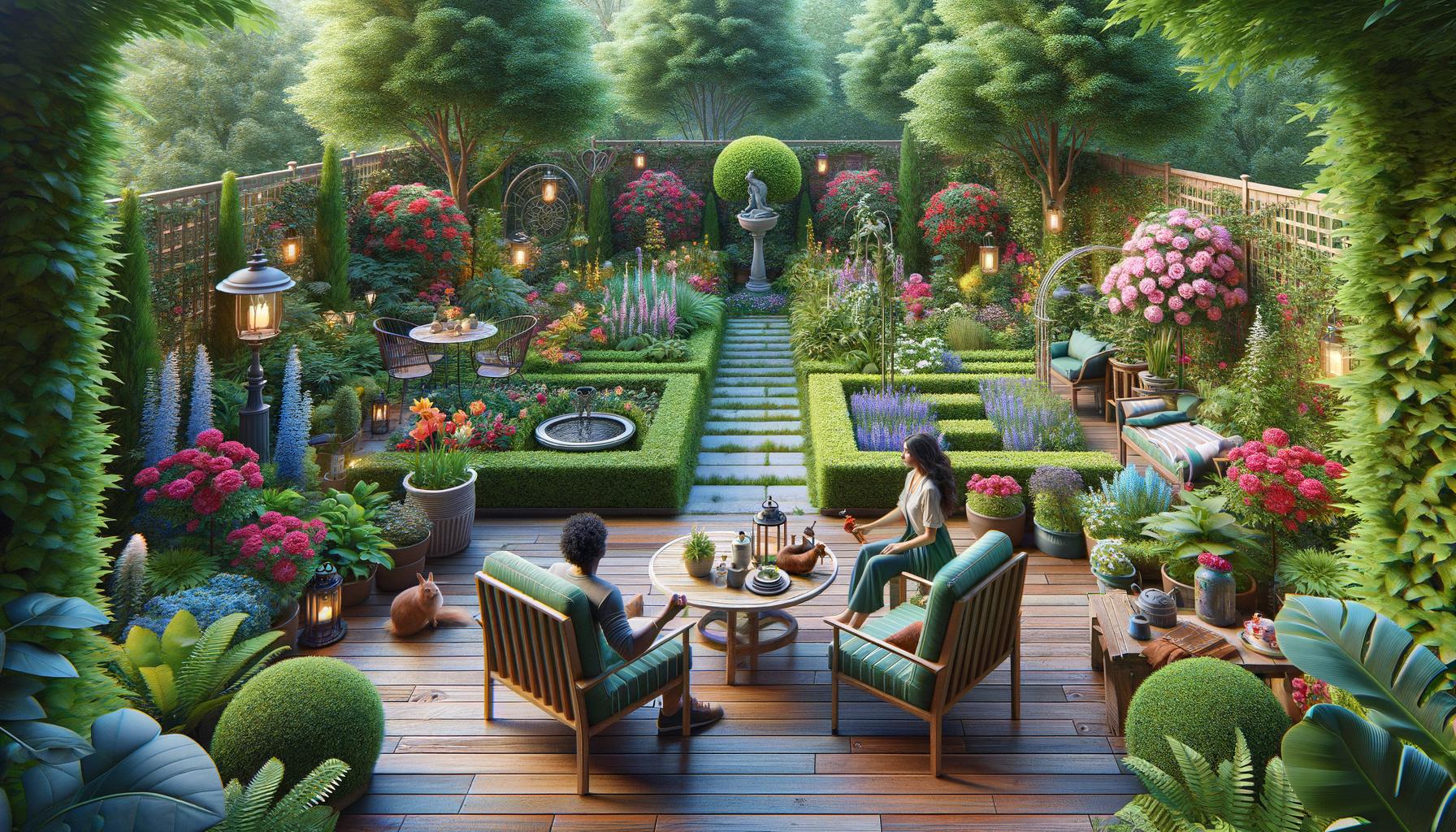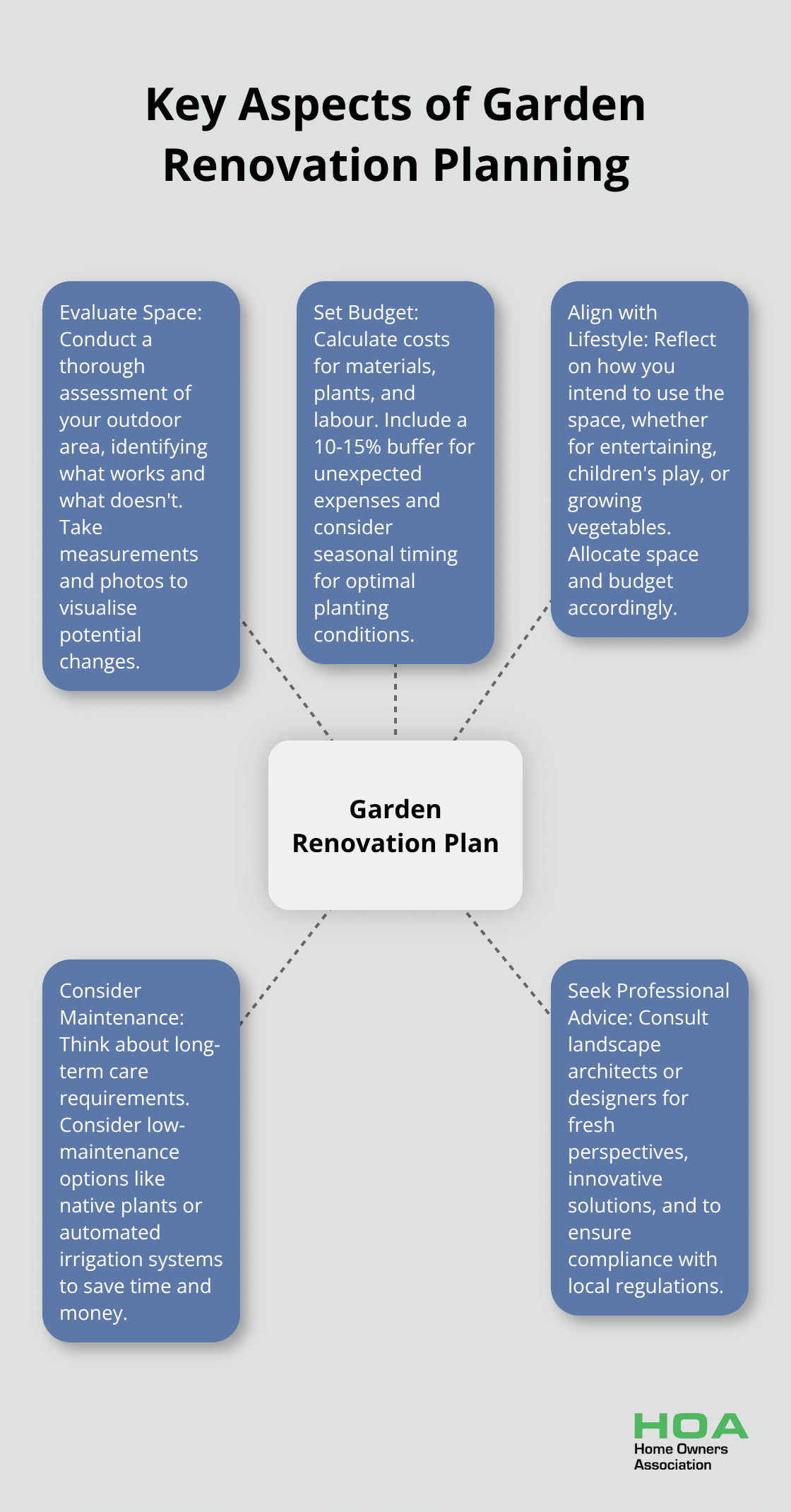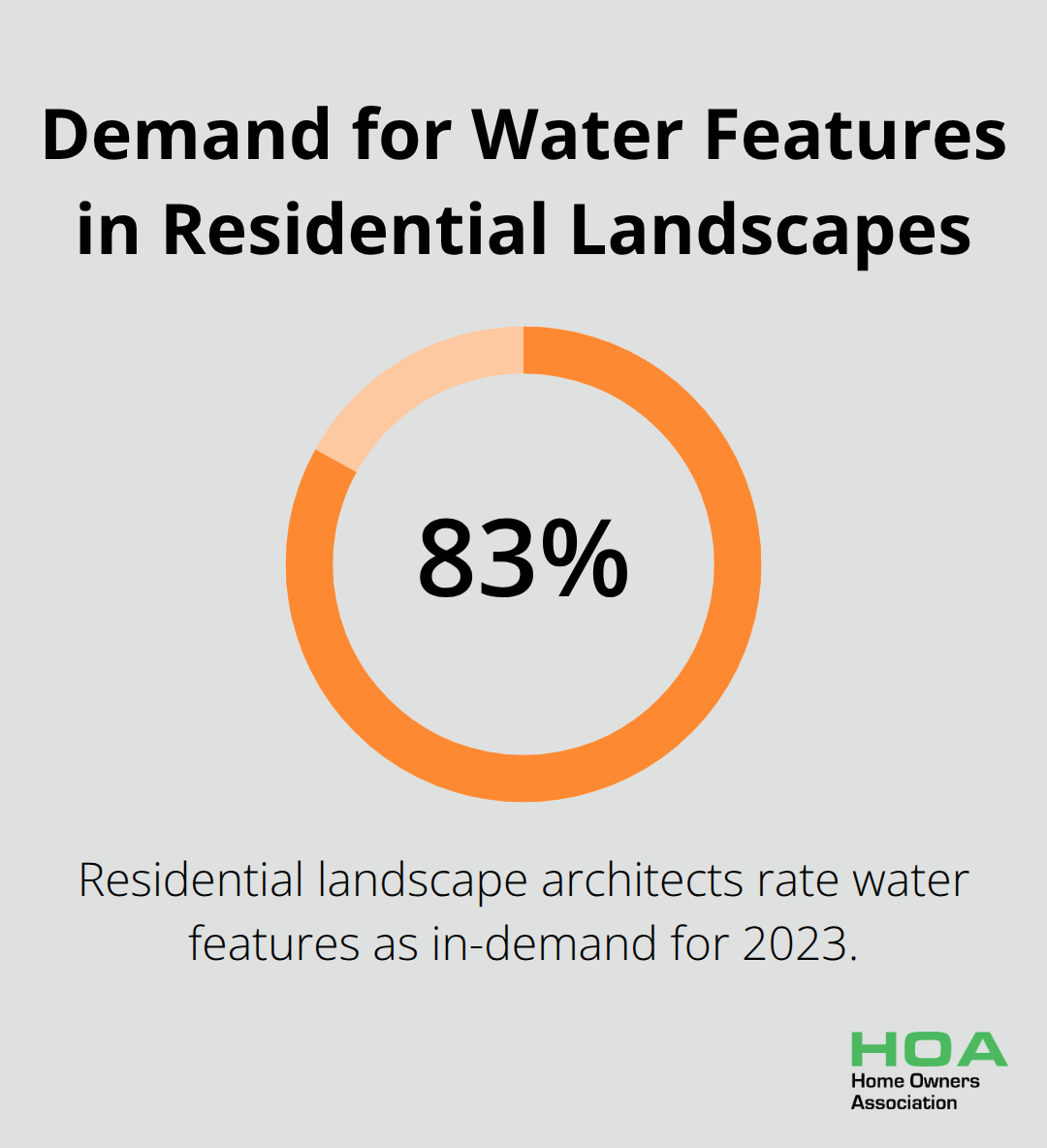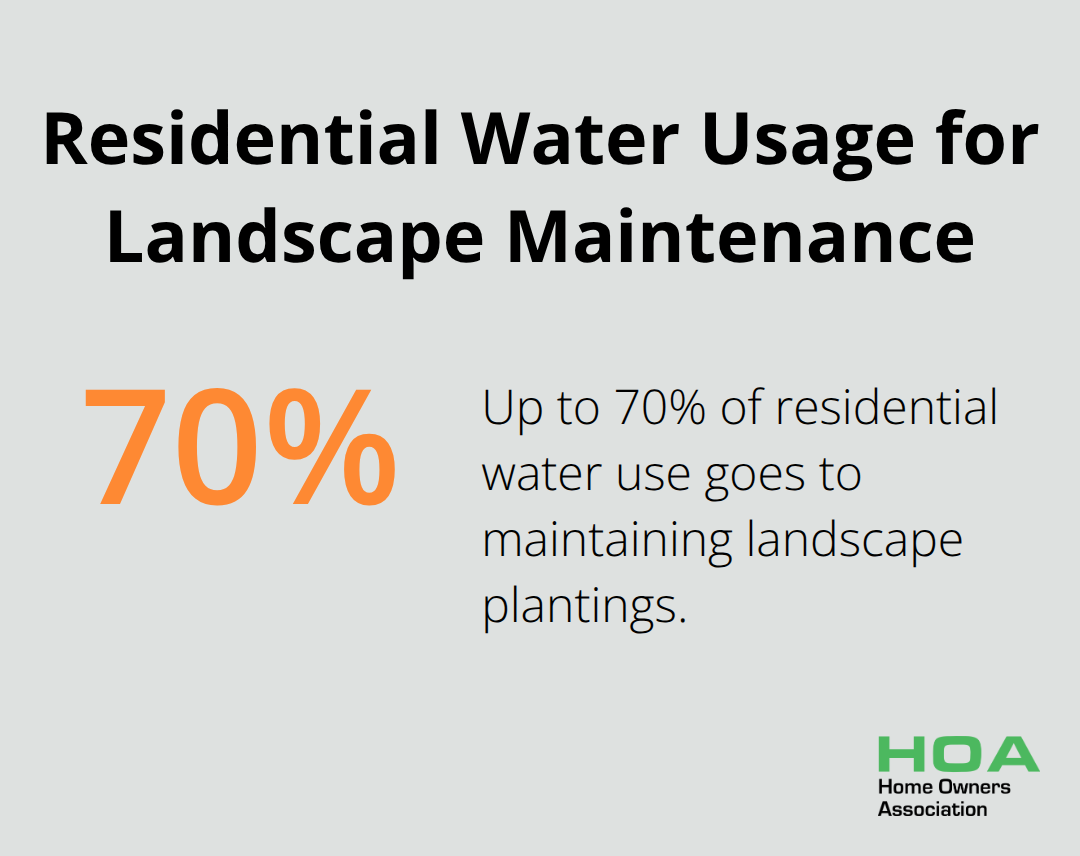
At Home Owners Association, we’re excited to share some inspiring garden renovation ideas to help you transform your outdoor space.
A well-designed garden can significantly enhance your property’s value and your quality of life. Whether you have a sprawling backyard or a compact patio, there are countless ways to create a beautiful and functional outdoor oasis.
In this post, we’ll explore innovative design elements, sustainable practices, and practical tips to guide you through your garden renovation journey.
How to Plan Your Garden Renovation
Evaluate Your Current Space
Start your garden renovation by conducting a thorough assessment of your outdoor area. Identify what works and what doesn’t. Take precise measurements and capture photos from various angles. This approach will help you visualise potential changes and effectively communicate your ideas to landscapers or designers.

Don’t overlook the importance of soil quality. Perform a simple pH test to determine what plants will thrive in your garden. The Royal Horticultural Society suggests that most plants prefer a pH between 6.0 and 7.0.
Set a Realistic Budget and Timeline
Garden renovations can range significantly in cost. Your budget might vary depending on the scope of your project.
Include costs for materials, plants, and labour in your calculations. Add a buffer of 10-15% for unexpected expenses (this practice can save you from financial stress later). Consider the seasons when planning your timeline. Spring and early autumn typically offer ideal planting conditions in most parts of Australia.
Align Your Garden with Your Lifestyle
Your garden should reflect your intended use of the space. Do you envision hosting outdoor dinner parties? Do you need a play area for children? Or perhaps you’re interested in growing your own vegetables?
If outdoor entertaining aligns with your goals, allocate more space and budget to a patio or deck area.
Consider Long-Term Maintenance
Think about the long-term care your new garden will require. Low-maintenance options (such as native plants or automated irrigation systems) can save you time and money in the future. Consider your willingness and ability to maintain different garden elements before including them in your plan.
Seek Professional Advice
While DIY can be rewarding, professional guidance can prove invaluable for complex renovations. Landscape architects and designers can offer fresh perspectives and innovative solutions you might not have considered. They can also help you avoid costly mistakes and ensure your renovation complies with local regulations.
With these planning steps in place, you’re ready to move on to the exciting part – exploring innovative design elements that will bring your garden vision to life.
Innovative Garden Design Elements That Transform Outdoor Spaces
Water Features as Captivating Focal Points
Water features add tranquility and visual interest to any garden. The American Society of Landscape Architects reports that 83% of residential landscape architects rate water features as in-demand for 2023. You can install a small fountain for compact spaces or a cascading waterfall for larger areas. The sound of flowing water masks urban noise and creates a peaceful atmosphere.

For a modern touch, try a sleek, geometric water wall. These features are not only visually striking but also relatively low-maintenance. (Don’t forget to factor in the cost of installation and ongoing maintenance when budgeting for water features.)
Vertical Gardening Solutions for Space Optimisation
Vertical gardening maximises your growing area while creating a stunning visual impact. The global market for living walls or green walls is expected to reach $1.5 billion by 2027 (according to Grand View Research).
You can implement a modular living wall system for easy installation and maintenance. These systems allow you to swap out plants seasonally or as needed. For a budget-friendly option, repurpose pallets or use hanging pocket planters. Vertical herb gardens near the kitchen door are both practical and aromatic.
Multi-functional Outdoor Rooms for Versatile Living
Modern garden design embraces multi-functional spaces that blend relaxation and entertainment. The National Association of Landscape Professionals reports that 61% of homeowners use their outdoor spaces for relaxing, while 57% use them for entertaining.
You can create distinct zones within your garden using different flooring materials or levels. A raised deck serves as an outdoor dining area, while a sunken fire pit becomes a cosy gathering spot. Incorporate weatherproof furniture and outdoor lighting to extend the usability of these spaces into the evening hours.
Innovative Lighting Solutions for Ambiance
Strategic lighting transforms your garden into a magical space after dark. Solar-powered pathway lights offer an eco-friendly option that requires minimal maintenance. For a whimsical touch, string fairy lights through trees or along fences.
Consider installing smart outdoor lighting systems that you can control with your smartphone. These systems allow you to adjust brightness and colour to suit different moods or occasions.
Sustainable Materials for Eco-Friendly Design
Incorporate sustainable materials into your garden design to reduce environmental impact. Recycled plastic lumber is an excellent alternative to traditional wood for decking and furniture. It’s durable, low-maintenance, and helps reduce plastic waste.
For hardscaping, consider permeable pavers that allow rainwater to seep into the ground, reducing runoff and supporting groundwater recharge. These innovative design elements will transform your outdoor space into a stunning and functional oasis. The next section will explore how to make your garden not just beautiful, but also sustainable through eco-friendly practices.
How to Make Your Garden More Sustainable
At Home Owners Association, we believe sustainable gardening practices are a necessity for our planet’s future. You can create a beautiful outdoor space that benefits the environment by implementing eco-friendly techniques in your garden renovation.
Choose Native Plants for Water Conservation
One of the most effective ways to create a sustainable garden is to select native plants. These species adapt naturally to your local climate and need less water and maintenance. Up to 70% of residential water use goes to maintaining landscape plantings. With increasing water scarcity, changing landscape preferences and choices can significantly reduce water consumption.

If you’re in New South Wales, you should plant Kangaroo Paw or Bottlebrush. These plants conserve water and attract local wildlife, which enhances biodiversity in your garden. You should research your specific region to find the best native plants for your area.
Install Smart Irrigation Systems
Water conservation extends beyond plant selection. You can significantly reduce water waste by installing a smart irrigation system. These systems use weather data and soil moisture sensors to determine when and how much to water your garden.
Smart irrigation systems can help analyse various types of drip and sprinkler irrigation systems with the help of IoT and find solutions for efficient water use.
Harvest Rainwater for Garden Use
Rainwater harvesting excellently reduces reliance on mains water supply. A simple rain barrel can collect thousands of litres of water annually (depending on your roof size and local rainfall).
For a more comprehensive system, you should install underground tanks. These can store larger volumes of water and connect to your irrigation system. The Australian Rainwater Harvesting Association states that a properly designed system can provide up to 100% of your garden’s water needs.
Use Eco-Friendly Hardscaping Solutions
When it comes to hardscaping, sustainable materials are key. You can use recycled concrete aggregates for pathways and patios. These materials reduce landfill waste and have a lower carbon footprint compared to new concrete.
For decking, you should consider composite materials made from recycled plastics and wood fibres. These are durable, low-maintenance, and resist rot and insect damage better than traditional timber.
Permeable paving is another excellent option. It allows water to seep through, which reduces runoff and helps recharge groundwater. The Landscape Industries Association of Western Australia reports that permeable paving can reduce stormwater runoff by up to 90% (a significant benefit for water conservation).
Final Thoughts
Garden renovation ideas transform outdoor spaces into beautiful, functional oases. These renovations enhance property value and improve quality of life, offering a perfect setting for relaxation and entertainment. Sustainable practices, such as native plant selection and eco-friendly materials, ensure gardens remain beautiful and thriving for years to come (while contributing to environmental conservation).
A well-designed outdoor space provides more than aesthetic appeal. It creates a sanctuary from daily stresses, connects you with nature, and offers opportunities for lasting memories with loved ones. The benefits of a thoughtfully renovated garden extend beyond its boundaries, positively impacting well-being and the environment.
We at Home Owners Association encourage you to take the first step in your garden transformation journey. Our team supports you with expert advice, resources, and exclusive benefits to ensure your garden renovation project succeeds. Start planning your garden renovation today and unlock the full potential of your outdoor space.





